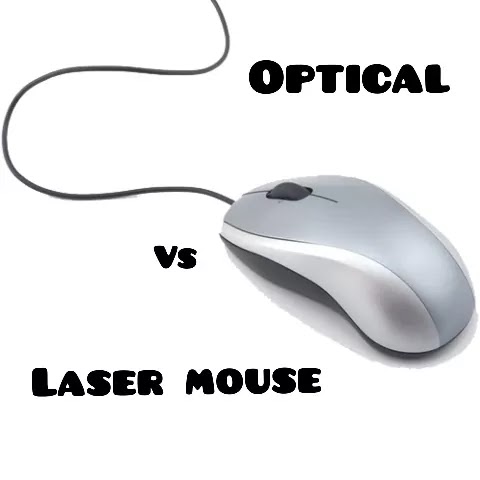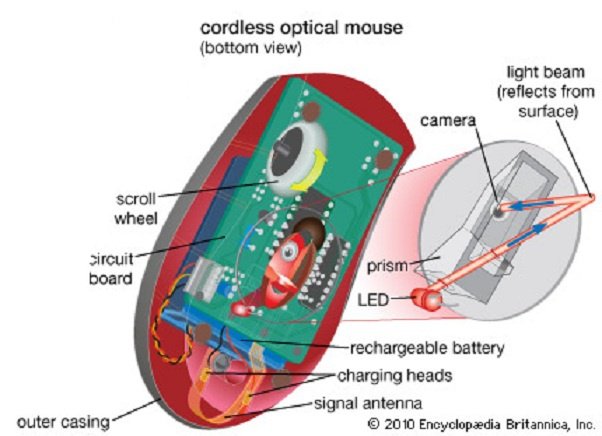Computer mouse is known as an input device which moves the cursor around the screen. The original mechanical computer mouse replaced the optical mouse and laser mouse. We looked at the differences between optical mice and laser mice to help you decide which type of computer mouse is right for you.
Overall Conclusion
| Optical Mouse | Laser Mouse |
| Uses an LED light as an illumination source. | Uses a laser as an illumination source. |
| Uses CMOS image sensors. | Uses CMOS image sensors. |
| Has a resolution of around 3,000 dpi. | Has resolutions between 6,000 and 15,000+ dpi. |
| Senses the top of the surface it’s on. | Senses peaks and valleys in a surface. |
| Works well on a mouse pad or non-glossy surface. | Works on any surface. |
| Inexpensive, generally cost $10 and up. | More expensive, but the price gap has narrowed. |
Although the internal technology is different in optical mice and laser mice, the average user may not notice the difference between the devices. Price used to be a factor when choosing between an optical mouse and a laser mouse, but the price difference has narrowed.
Other factors may drive your choice, for example, if specific applications or circumstances call for certain features. Hardcore gamers may need a mouse with specialized functionality. If you need flexibility, choose a mouse that works on any surface.
Difference between optical mouse and laser mouse
1. Optical Mouse :
Optical mouse illuminates the surface with infrared LED light and works better on mouse pads and non glossy surface. It is first used in 1980 by Mouse Systems Corporation and Xerox and first commercially used by Microsoft in 1999. Its resolution of around 3, 000 DPI.
Pros of Optical Mouse –
- Generally better price-quality ratio
- More accurate
Cons of Optical Mouse –
- Must be used on a non-reflective surface
2. Laser Mouse :
Laser mouse illuminates the surface with a laser beam and it has no such any preferred surface for working. It is first used in 1998 by Sun Microsystems and it is first commercially used by Logitech MX 1000 in 2004. It resolution of 6, 000 to 15, 000 DPI.
Pros of Laser Mouse –
- Can be used on almost any surface
- Higher DPI
Cons of Laser Mouse –
- Over-analyzing on slower movements
What is the difference between optical and laser mice in terms of technology ?
| Optical Mouse | Laser Mouse |
| LED light is the illumination source. | Laser is the illumination source. |
| Lower dpi than a laser mouse. | Higher dpi, so it’s more sensitive. |
| Surface illumination. | Deep illumination. |
Optical and laser mice differ in the type of technology used to track movement. Optical mouse uses LED light as the source of illumination. The laser mouse, as its name indicates, uses a laser.
Optical mice have a resolution of around 3,000 dpi, while laser mice have a resolution between 6,000 and 15,000+ dpi. Since laser mice have a higher DPI, these devices track more points per inch and are more sensitive. This may have been a problem in the past, but the average user can’t tell the difference.
However, some users, such as gamers and graphic designers, may notice the difference and prefer a laser mouse or specialized mouse.
How do laser and optical mice differ according to surface ?
| Optical Mouse | Laser Mouse |
| Senses the top of a surface. | Senses more deeply into surface. |
| Smooth feel at slow speeds. | Jittery feel at slow speeds. |
| Works best on a mouse pad or non-glossy surface. | Works on any surface. |
| Few acceleration problems. | Can be prone to acceleration problems. |
An optical mouse usually only feels the top of the surface it is on, such as a cloth mouse pad. But the laser sees light more deeply, so it is sensitive to peaks and valleys on the surface.
There is one drawback to the sensitivity of the laser mouse. It is sensitive to speed-related accuracy variance, or acceleration. If you move your mouse over its mouse pad quickly and slowly return it to its original position, the cursor on the screen should also return to its initial position. If it doesn’t, the mouse suffers from acceleration.
Optical mice aren’t as sensitive as laser mice, so you can’t use them on many surfaces, but they aren’t as sensitive to acceleration.
An optical mouse works well on a mouse pad or any non-glossy surface. The laser mouse works on any surface. If you plan to use your mouse on shiny surfaces, you may need a laser mouse.


